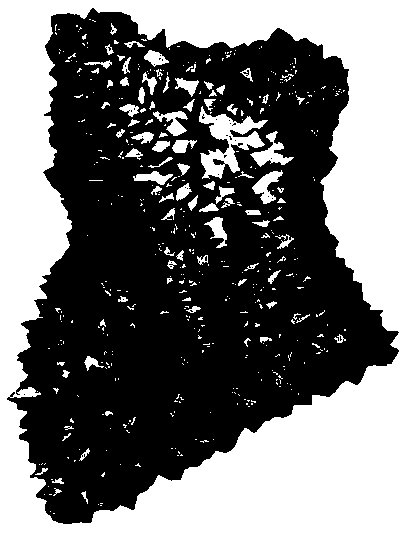A dual-normal mesh model fairing method based on vertex characteristics
A mesh model and vertex technology, which is applied in the field of smoothing of two-normal mesh models based on vertex features, and can solve problems such as vertex offset, blurred mesh detail features, and shape distortion.
- Summary
- Abstract
- Description
- Claims
- Application Information
AI Technical Summary
Problems solved by technology
Method used
Image
Examples
Embodiment 1
[0153] A method for smoothing a double-normal mesh model based on vertex features, mainly comprising the following steps:
[0154] 1) Using tensor voting theory, divide all vertices in the grid model into feature points and non-feature points.
[0155] Further, the main steps of dividing the vertices of all triangular patches in the triangular mesh model into feature points and non-feature points are as follows:
[0156] 1.1) Calculate the normal tensors of all the vertices of the triangular patches in the triangular mesh model.
[0157] The jth triangle facet f of the triangular mesh model j vertex v i tensor of is the neighborhood triangle normal covariance matrix weight and .
[0158] vertex v i The normal tensor of As follows:
[0159]
[0160] In the formula, N f (v i ) is the vertex v i The first-order neighborhood triangle of . is the weight. f j is the jth triangular patch of the triangular mesh model. is the triangular facet f j The unit normal...
Embodiment 2
[0298] A smoothing experiment of a dual-normal mesh model based on vertex features, mainly including the following experiments:
[0299] 1) Determine that the grid model is the Fandisk noise-adding model, such as figure 1 shown. Using bilateral filtering algorithm, bilateral normal filtering method, optimization-based double normal filtering, joint bilateral filtering and the method of the present invention to compare respectively, as Figures 2 to 6 shown.
[0300] II) Determine that the grid model is a support noise model, such as Figure 7 shown. Using bilateral filtering algorithm, bilateral normal filtering method, optimization-based double normal filtering, joint bilateral filtering and the method of the present invention to compare respectively, as Figures 8 to 12 shown.
[0301] III) Determine the grid model as the cylinder head model, such as Figure 13 shown. Using Laplace method, bilateral filtering algorithm, bilateral normal filtering method, joint bilater...
PUM
 Login to View More
Login to View More Abstract
Description
Claims
Application Information
 Login to View More
Login to View More - R&D
- Intellectual Property
- Life Sciences
- Materials
- Tech Scout
- Unparalleled Data Quality
- Higher Quality Content
- 60% Fewer Hallucinations
Browse by: Latest US Patents, China's latest patents, Technical Efficacy Thesaurus, Application Domain, Technology Topic, Popular Technical Reports.
© 2025 PatSnap. All rights reserved.Legal|Privacy policy|Modern Slavery Act Transparency Statement|Sitemap|About US| Contact US: help@patsnap.com



